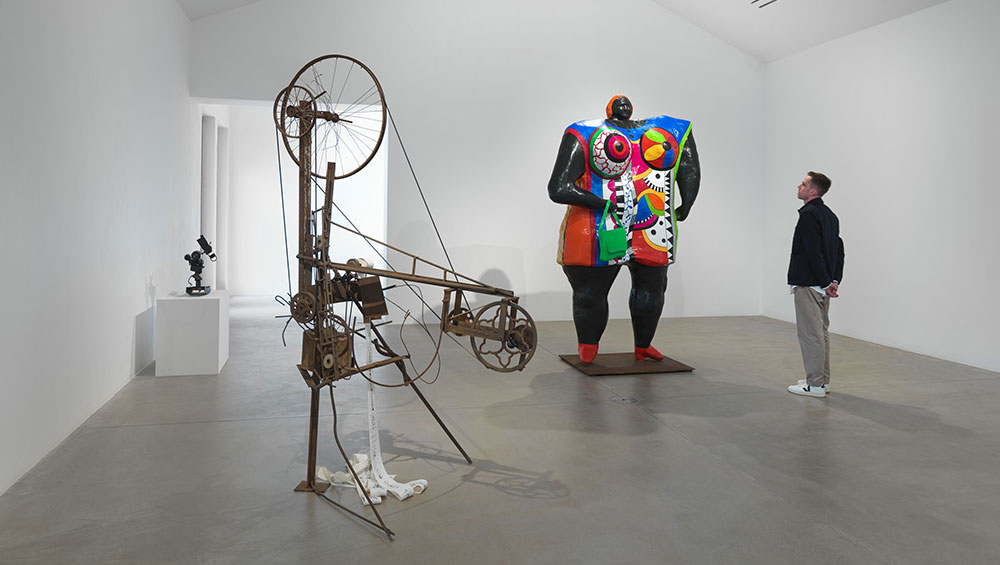
Niki de Saint Phalle & Jean Tinguely. Myths & Machines, installation view, Hauser & Wirth Somerset, 2025. © Niki Charitable Art Foundation. All Rights Reserved, DACS 2025. © Jean Tinguely, DACS 2025. Photo: Ken Adlard. Courtesy the artists and Hauser & Wirth.
Hauser & Wirth Somerset
17 May 2025 – 1 February 2026
by DAVID TRIGG
The differences between the visual languages employed by Niki de Saint Phalle (1930-2002) and Jean Tinguely (1925-1991) are pronounced. She is best known for her large, colourful sculptures of voluptuous female figures called Nanas, while he was a pioneer of kinetic art, creating motorised scrap-metal sculptures that combine movement and sound. From the 1950s, their work developed in parallel and often collaboratively in a curious creative partnership that extended beyond their fiery personal relationship (they were married in 1971 but separated just two years later) until Tinguely’s death. Presented at Hauser & Wirth Somerset on the centenary of Tinguely’s birth, this exhibition displays the artists’ works side by side, demonstrating how, despite their singular aesthetics, both were united in their playful and rebellious approach to art-making.
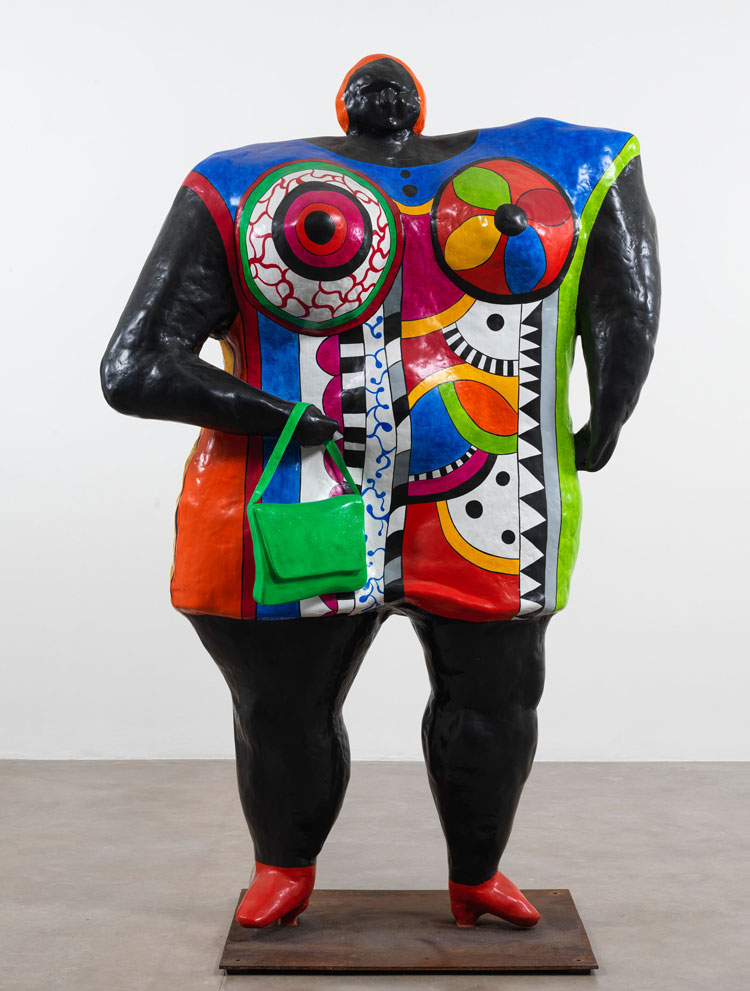
Niki de Saint Phalle, Big Lady (Black), 1968/1995. Painted polyester, pen, metal base, (47 x 157 x 80 cm (97 1/4 x 61 3/4 x 31 1/2 in). Installation view, Hauser & Wirth Somerset, 2025. © Niki Charitable Art Foundation. All Rights Reserved, DACS 2025. © Jean Tinguely, DACS 2025. Photo: Ken Adlard. Courtesy the artists and Hauser & Wirth.
In the first room, half-a-dozen kinetic contraptions are overseen by a vibrantly decorated Nana. Titled Big Lady (Black) (1968/1995), the towering figure belongs to a series that Saint Phalle created in tribute to black women – a statement of solidarity with the civil rights movement in the US that still resonates today. She watches as Tinguely’s works intermittently spring to life, whirring and clunking with slow, graceful motion. Originally, they would have been operated by pushbuttons but now, too old and fragile, they are programmed to move briefly every 10 or so minutes. That is, if they are working at all: a delicate drawing machine from 1959 remains inoperative, while another assemblage of industrial cast-offs atop a tree stump had broken down during my visit. Yet their contemporary relevance is not dampened, speaking as they do to present anxieties over the shortcomings of modern technology, from automation to machine learning.
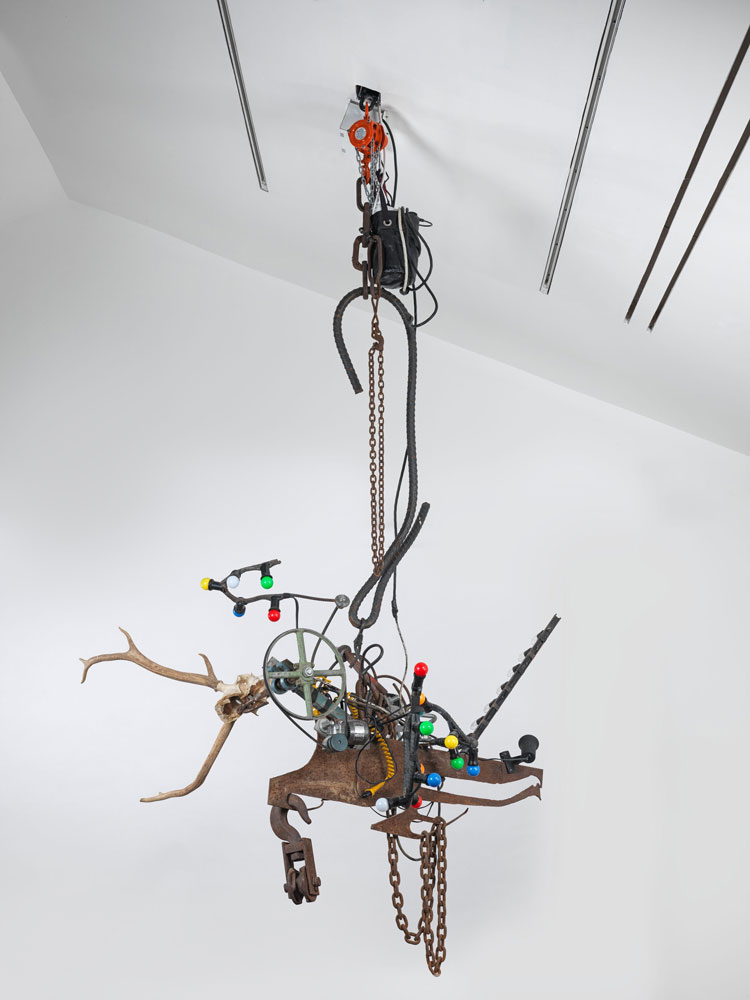
Jean Tinguely, Chandelier, 1989-90. Metal, plastic components, antlers, colored light bulbs, 254 x 172.7 x 152.4 cm (100 x 68 x 60 in). Installation view, Hauser & Wirth Somerset, 2025. © Niki Charitable Art Foundation. All Rights Reserved, DACS 2025. © Jean Tinguely, DACS 2025. Photo: Ken Adlard. Courtesy the artists and Hauser & Wirth.
Looking closer, you begin to spot signs of how these two artists influenced each other in the studio: the Nana’s patterned dress, for instance, resembles cogs and wheels while, at the other end of the room, Saint Phalle’s eye-catching palette is echoed in Tinguely’s Chandelier (1989-90), a suspended tangle of metal and plastic components with a pair of antlers and a string of red, green, orange, blue, white and yellow lightbulbs – colours all found on Big Lady (Black). But it is in the artists’ collaborative endeavours that you see how they successfully synthesised their individual ways of working.
Uniting Tinguely’s rusted industrial components with Saint Phalle’s jaunty figuration, La Grande Tête (1988) is a stylised, black-and-white face with bright red lips and a lightbulb crown mounted on a mechanical base that slowly turns it from side to side. In another room, Pallas Athéna (Le Chariot) (1989) features a small, buxom Nana styled as the Greek goddess Athena who rides on a decrepit chariot-like apparatus that creaks and squeaks as it carries her back and forth. Nearby, a revolving Nana takes centre stage in Nana Machine (1976), twirling atop an iron stand like a ballerina performing an arabesque. In all these collaborations, it is Tinguely’s mechanics that support and animate his partner’s figures. For him, there was great joy to be found in turning static objects into living performances, yet Saint Phalle was quite capable of evoking movement without him, as evidenced by Les Trois Graces (The Three Graces) (1995-2003), installed outside on the front lawn. The monumental dancing figures are adorned with mosaic tiles and mirror fragments; their carefree poses and joyful energy expressing an empowered femininity.
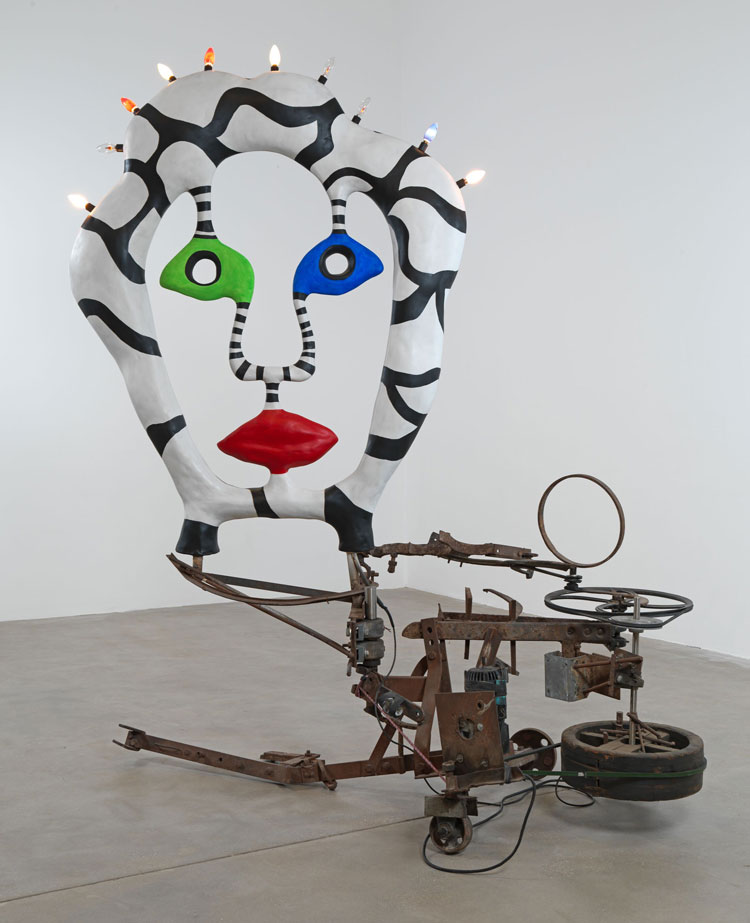
Niki de Saint Phalle, La Grande Tête, 1988. Iron, wood, electric motor, bungee, lightbulbs, polyester head, 225 x 225 x 140 cm (88 5/8 x 88 5/8 x 55 1/8 in). Installation view, Hauser & Wirth Somerset, 2025. © Niki Charitable Art Foundation. All Rights Reserved, DACS 2025. © Jean Tinguely, DACS 2025. Photo: Ken Adlard. Courtesy the artists and Hauser & Wirth.
The two artists worked together on several monumental projects, including Le Cyclop (1969-94), an immense walk-in head covered in sparkling mirrors, which dominates the forest of Milly-la-Forêt in France; Le Crocrodrome (1977), a 30-metre dragon at the Centre Pompidou in Paris with a ghost train, marble run, and other interactive elements in its belly; and La Fontaine Stravinsky (1983), a playful fountain built in front of the same museum. In the early 70s, the pair collaborated on the film Un Rêve Plus Long Que La Nuit (A Dream Longer Than the Night, 1976), a fantastical oneiric exploration of female desire. Several highly stylised furniture props from the film – all created by Saint Phalle in 1974 – are displayed here for the first time, including a golden mirror, a throne, a bed frame, a bird cage, and an object resembling the Ark of the Covenant, all of which appear to have fallen straight out of a fairytale.
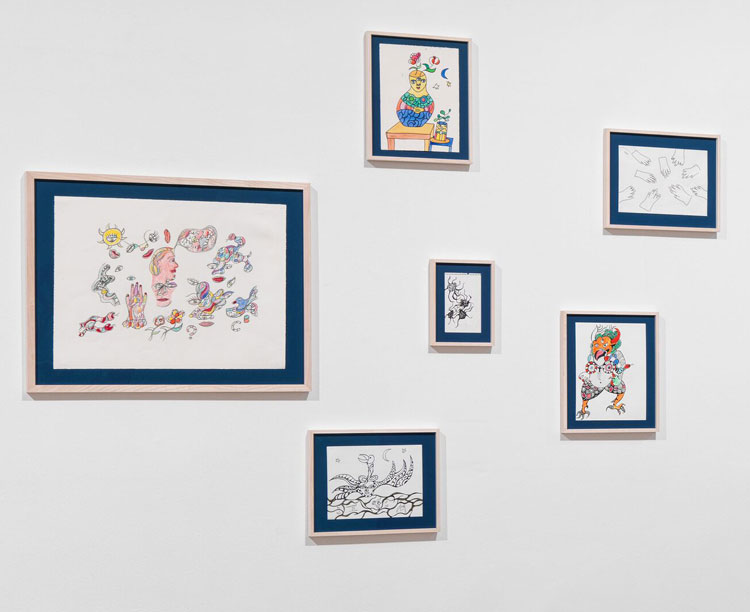
Niki de Saint Phalle & Jean Tinguely. Myths & Machines, installation view, Hauser & Wirth Somerset, 2025. © Niki Charitable Art Foundation. All Rights Reserved, DACS 2025. © Jean Tinguely, DACS 2025. Photo: Ken Adlard. Courtesy the artists and Hauser & Wirth.
Also never exhibited before are a selection of 30 works on paper by Saint Phalle: whimsical drawings filled with animals, fantastical creatures and cartoon-like doodles that complement her and Tinguely’s quirky sculptures. But there are sombre themes here too. The spectre of mortality confronts viewers in Tinguely’s Le Cercle Infernal de la Mort (The Infernal Circle of Death, 1990), for which the artist bolted 11 roebuck skulls to a rotating iron wheel mounted on a tree stump.
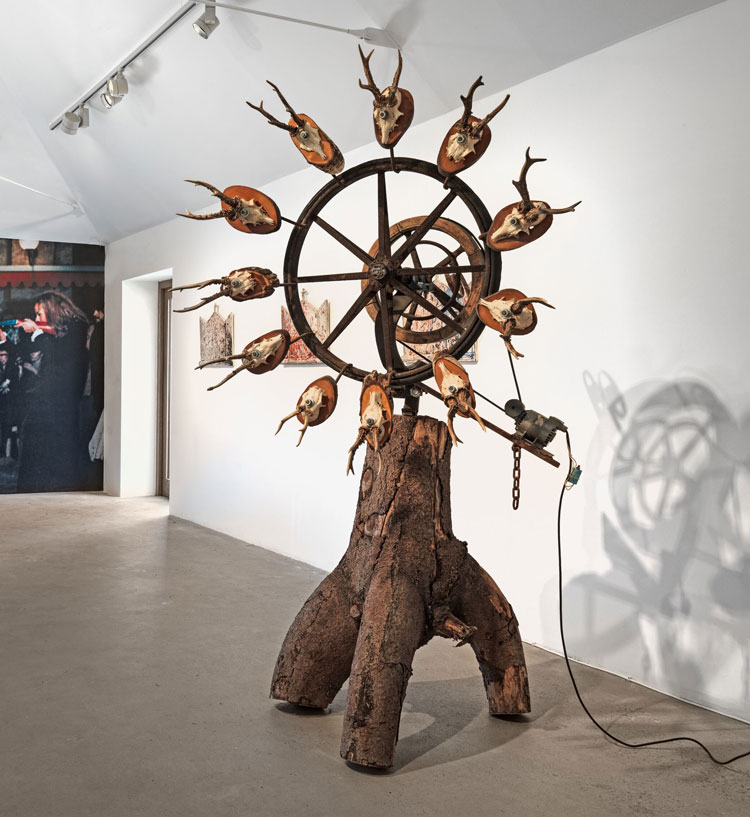
Jean Tinguely. Le Cercle Infernal de la Mort (The Infernal Circle of Death), 1990. Installation view, Hauser & Wirth Somerset, 2025. © Niki Charitable Art Foundation. All Rights Reserved, DACS 2025. © Jean Tinguely, DACS 2025. Photo: Ken Adlard. Courtesy the artists and Hauser & Wirth.
It is also seen in Saint Phalle’s Autel Doré (Golden Altar, 1962-95), an altarpiece with mutilated dolls embedded in its wings – a chilling allusion to the Massacre of the Innocents. Three smaller and paint-spattered altarpieces are displayed nearby, each one embedded with animal and human figurines. Each Petit Autel (Small Altar, 1970-72) relates to her “Tirs” (shooting paintings) that she began in 1961 and which involved firing a gun at paint-filled containers, causing them to explode over her sculptural reliefs. It is hard not to read these altarpieces as an expression of Saint Phalle’s rage against her strict Catholic upbringing and abusive father. They also recall Tinguely’s taste for incendiarism, as seen in his auto-destructive sculptures.
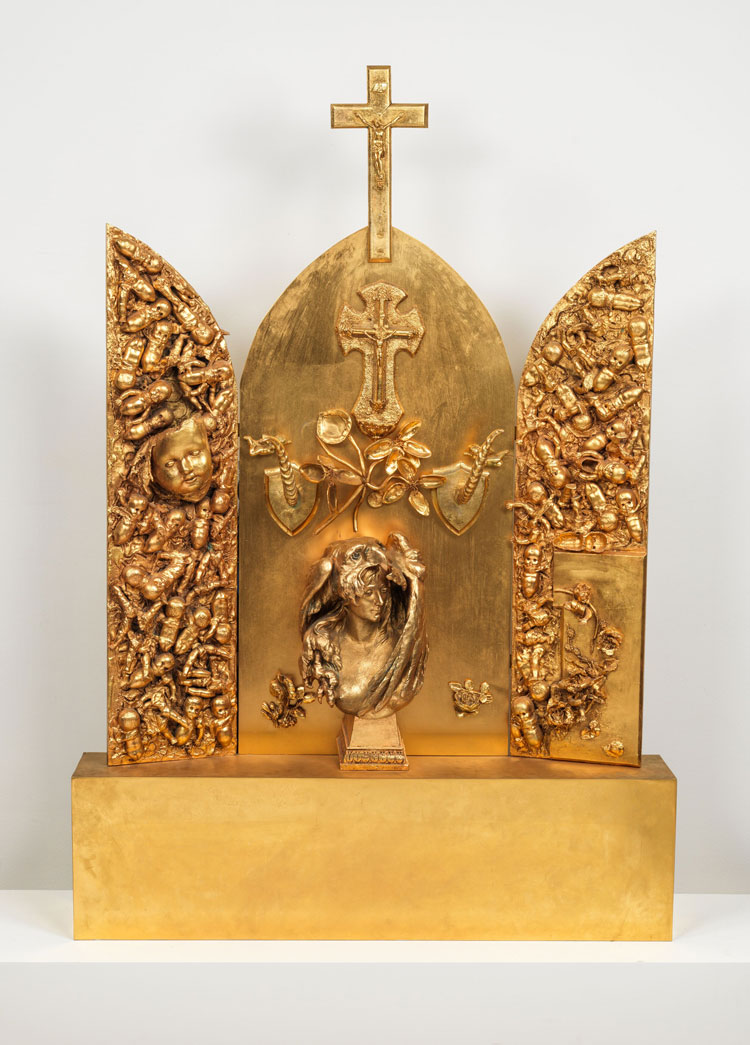
Niki de Saint Phalle, Autel doré (Golden Altar), 1962 – 1995. Gold bronze and varnish, elements bathed in gold bronze, 160 x 111 x 17.5 cm (63 x 43 3/4 x 6 7/8 in). © Niki Charitable Art Foundation. All Rights Reserved, DACS 2025. Courtesy Niki Charitable Art Foundation and Hauser & Wirth. Photo: Ken Adlard.
On paper, Saint Phalle and Tinguely made for an odd couple. She was from French aristocratic stock, he had a Swiss working-class background. Both, however, were radical figures, eager to challenge artistic norms and social conventions, and both were committed to using art as a tool for social commentary and a catalyst for transformation. It was this shared outlook that brought them together and their subsequent tumultuous relationship that spurred them on, individually and as a collaborative force.